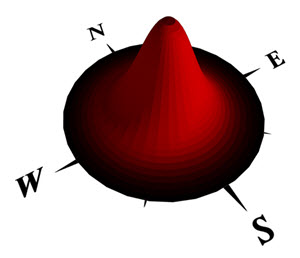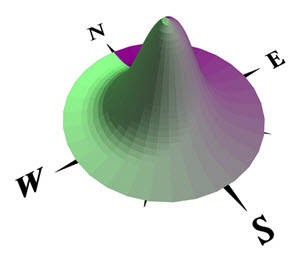geometry.angle function
Syntax
- float geometry.angle(angleType)
Parameters
- angleType—selectorSelector for the angle calculation.
- maxSlope—Calculates the maximum slope of the shape, relative to the xz-plane, in degrees.
- azimuth—Calculates the azimuth of the direction of the current shape's maximum slope, in degrees;
- zenith—Calculates the difference between 90 degrees (zenith) and the maximum slope.
Returns
Angle of the current shape's geometry, depending on the selector, in degrees.
Description
The geometry.angle function calculates the angle of current shape's geometry. Azimuth is the horizontal angle measured clockwise from the north, i.e. 90 degrees is east, 180 degrees is south and 270 degrees is west. The Azimuth is in the range [0, 360]. The geometry.angle(zenith) function returns the same value as ( 90 - geometry.angle(maxSlope) )
Examples
|  |
|  |
geometry.area function
Syntax
- float geometry.area()
- float geometry.area(faceOrientation)
Parameters
- faceOrientation—selectorSelector for the faces to include in the area calculation.
- {surface| all } (default)
- { front | back | left | right | top | bottom }
- { object.front | object.back | object.left | object.right | object.top | object.bottom | object.side }
- { world.south | world.north | world.west | world.east | world.up | world.down | world.side }
- { street.front | street.back | street.left | street.right | street.side }
Returns
Surface area of the current shape's geometry, depending on the provided area selector.
Description
The geometry.area function calculates the surface area that is the sum of all its faces.
geometry.boundaryLength
Syntax
- float geometry.boundaryLength()
Returns
The sum of all boundary edge lengths. An edge is considered a boundary edge if it belongs to no more than one face.
Related
geometry.{du|dv} functions
Syntax
- float geometry.du(uvSet, surfaceParameterization)
- float geometry.dv(uvSet, surfaceParameterization)
Parameters
- uvSet—floatNumber of texture coordinates set (integer number [0,9]). The numbering corresponds to the texture layers of the material attribute, see also texturing: essential knowledge.
- surfaceParameterization—selector
The surface parameter space.
- uvSpace—Selects the actual texture coordinates (typically in the range [0,1]).
- unitSpace —Calculates the geometry-dependent surface stretch along the u- or v- axis and calculates an approximation in world coordinate units (e.g. meters).
Returns
The range (i.e. max - min) spanned by the u- or the v-coordinate, respectively, of the selected uvset.
Related
geometry.height function
Syntax
- float geometry.height()
Returns
The height of the geometry in world coordinates.
Related
geometry.isClosedSurface function
Syntax
- bool geometry.isClosedSurface()
Returns
true if the geometry contains at least one face and all edges belong to exactly 2 faces, false otherwise.
Related
geometry.isConcave function
Syntax
- bool geometry.isConcave()
Returns
true if the geometry contains at least one concave face, false otherwise.
Related
geometry.isInstanced function
Syntax
- bool geometry.isInstanced()
Returns
True if the current shape's geometry is the instance of an asset, i.e. the geometry has not been altered since the insert operation , false otherwise.
Description
The geometry.isInstanced() function can be used to e.g. check if an inserted asset was trimmed.
Related
geometry.isOriented function
Syntax
- bool geometry.isOriented(orientation)
Parameters
- orientation—selectorSelector for the faces to check for.
- { front | back | left | right | top | bottom | side }
- { object.front | object.back | object.left | object.right | object.top | object.bottom | object.side }
- { world.south | world.north | world.west | world.east | world.up | world.down | world.side }
- { street.front | street.back | street.left | street.right | street.side }
Returns
true if at least one of the geometry's faces matches the orientation selector, false otherwise.
Description
The geometry.isOriented function can be used to determine a shape's orientation.
Related
geometry.isPlanar function
Syntax
- bool geometry.isPlanar(tolerance)
Parameters
- tolerance—floatThe tolerance in degrees for deciding if an face is planar or not. The face normal is compared to the edges' cross product (''local normal'') at every vertex; if the angle between a ''local normal'' and the face normal is larger than the tolerance the face is non-planar. A reasonable value is 0.25 degrees.
Returns
true if the geometry contains at least one face and all faces of are planar (within tolerance), false otherwise).
Related
geometry.isRectangular function
Syntax
- bool geometry.isRectangular(tolerance)
Parameters
- tolerance—floatThe tolerance in degrees for deciding if an angle is a right one or not.
Returns
true if the geometry contains at least one face and all faces consist of 4 vertices and contain only right angles, false otherwise. Angles in the range [90-tolerance, 90+tolerance] are considered to be "right".
Related
geometry.nEdges function
Syntax
- float geometry.nEdges()
Returns
The (integral) number of edges of the current shape's geometry.
Related
geometry.nFaces function
Syntax
- float geometry.nFaces()
Returns
The (integral) number of faces of the current shape's geometry.
Related
geometry.nHoles function
Syntax
- float geometry.nHoles()
Returns
The (integral) number of holes (i.e. holes in faces) of the current shape's geometry.
Related
geometry.nVertices function
Syntax
- float geometry.nVertices()
Returns
The (integral) number of vertices of the current shape's geometry.
Related
geometry.{uMin|uMax|vMin|vMax} functions
Syntax
- float geometry.uMin()
- float geometry.uMax()
- float geometry.vMin()
- float geometry.vMax()
- float geometry.uMin(uvSet)
- float geometry.uMax(uvSet)
- float geometry.vMin(uvSet)
- float geometry.vMax(uvSet)
Parameters
- uvSet—floatNumber of texture coordinates set (integer (range[0,9]). The numbering corresponds to the texture layers of the material attribute, see also texturing: essential knowledge.
Returns
The minimal or maximal u or v value of the selected uvset (the versions without parameter use uvset 0).
geometry.volume function
Syntax
- float geometry.volume()
Returns
Volume of the current shape's geometry.